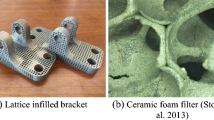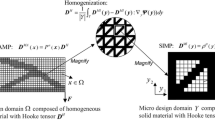Abstract
Estimation of mechanical properties of porous materials is central for their medical and industrial application. However, the massive size of accurate boundary representations (B-Rep) of the foams makes the numerical estimations intractable. Even for small domain sizes, the mesh generation for finite element analysis (FEA) may not terminate. Current efforts for simulating porous materials use statistical predictions of the material structure. The simulated and actual materials present different geometry and topology, with consequences on the simulation results. To overcome these limitations, this manuscript presents a method, which (1) synthesizes an accurate truss abstraction from the raw geometry data, (2) executes efficient FEA simulations, and (3) processes nodal displacements to estimate apparent mechanical moduli of the porous material. The method addresses materials whose ligaments have circular cross-sections. The iso-surface present in the Computer Tomography (CT) scan of the porous material is used to synthesize a truss graph whose edges are truncated cones. Then, optimization and simplification methods are applied to produce a topologically and geometrically correct truss representation for the foam domain. Comparative FEA load simulations are conducted between the full B-Rep and truss representations of the material. The truss model proves to be significantly more efficient for FEA, departing from the Full B-Rep FEA by a maximum of 16% in the estimation of equivalent mechanical moduli. Geometric assessments such as porosity and Hausdorff distance confirm that the truss abstraction is a cost-effective one. Ongoing efforts concentrate on point set geometric algorithms for enforcement of standardized material testing.



























Similar content being viewed by others
Abbreviations
- BB:
-
Bounding box
- B-Rep:
-
Boundary representation of a solid in \(R^3\). The usual topological hierarchy: BODY (3D), LUMP (3D), SHELL (2D), FACE (2D), LOOP (1D), EDGE (1D), VERTEX (0D). FACEs (i.e. ’trimmed surfaces’) may be mounted on either smooth surfaces or planes (triangles)
- CT:
-
Computer tomography
- FE:
-
Finite element
- FEA:
-
Finite element analysis
- FEM:
-
Finite element method
- MCF:
-
Mean curvature flow
- Reference model:
-
Model to measure the simplification against. In this manuscript the Reference model is the Full B-Rep of the foam
- \(\epsilon _{k}\) :
-
Strain in k direction
- \(E(\epsilon )_k\) :
-
Apparent Young Modulus at strain \(\epsilon\) caused by loads in k direction
- \(G(\epsilon )_k\) :
-
Apparent Shear Modulus at strain \(\epsilon\) caused by loads in k direction
- \(V(\epsilon )_{ij}\) :
-
Apparent Poisson ratio computed from a contraction in j direction given an extension in i direction
- \(\phi\) :
-
Porosity of a porous material sample
References
Kou XY, Tan ST (2010) A simple and effective geometric representation for irregular porous structure modeling. Comput Aided Des 42(10):930–941
Li H, Yang J, Su P, Wang W (2012) Computer aided modeling and pore distribution of bionic porous bone structure. J Central South Univ 19:3492–3499
Ettrich J, August A, Roelle M, Nestler B (2014) Digital representation of complex cellular structures for numerical simulations. In Cellular Materials: Proceedings CELLMAT 2014, pp 1–8. Deutsche Gesellschaft fuer Materialkunde,Fraunhofer-Institut fuer Angewandte Materialforschung
De Jaeger P, TJoen C, Huisseune H, Ameel B, De Paepe M (2011) An experimentally validated and parameterized periodic unit-cell reconstruction of open-cell foams. J Appl Phys 109(10):103519
Lautensack C (2008) Fitting three-dimensional laguerre tessellations to foam structures. J Appl Stat 35(9):985–995
Jang W, Kraynik AM, Kyriakides S (2008) On the microstructure of open-cell foams and its effect on elastic properties. Int J Solids Struct 45(7):1845–1875
Redenbach C (2009) Microstructure models for cellular materials. Computat Mater Sci 44(4):1397–1407
Jang W, Hsieh W, Miao C, Yen Y (2015) Microstructure and mechanical properties of alporas closed-cell aluminium foam. Mater Char 107:228–238
Michailidis N, Stergioudi F, Omar H, Tsipas DN (2010) An image-based reconstruction of the 3d geometry of an al open-cell foam and fem modeling of the material response. Mech Mater 42(2):142–147
Saenger EH, Uribe D, Jänicke R, Ruiz O, Steeb H (2012) Digital material laboratory: wave propagation effects in open-cell aluminium foams. Int J Eng Sci 58:115–123
Natesaiyer K, Chan C, Sinha-Ray S, Song D, Lin CL, Miller JD, Garboczi EJ, Forster AM (2015) X-ray ct imaging and finite element computations of the elastic properties of a rigid organic foam compared to experimental measurements: insights into foam variability. J Mater Sci 50(11):4012–4024
Ranut P, Nobile E, Mancini L (2014) High resolution x-ray microtomography-based cfd simulation for the characterization of flow permeability and effective thermal conductivity of aluminum metal foams. Experimental Thermal and Fluid Science
Zafari M, Panjepour M, Emami MD, Meratian M (2015) Microtomography-based numerical simulation of fluid flow and heat transfer in open cell metal foams. Appl Thermal Eng 80:347–354
Lu Z, Liu Q, Chen X (2014) Analysis and simulation for tensile behavior of anisotropic open-cell elastic foams. Appl Math Mech 35:1437–1446
Boomsma K, Poulikakos D (2001) On the effective thermal conductivity of a three-dimensionally structured fluid-saturated metal foam. Int J Heat Mass Transf 44(4):827–836
Jang W, Kyriakides S, Kraynik AM (2010) On the compressive strength of open-cell metal foams with kelvin and random cell structures. Int J Solids Struct 47(21):2872–2883
Randrianalisoa J, Baillis D, Martin CL, Dendievel R (2015) Microstructure effects on thermal conductivity of open-cell foams generated from the laguerre-voronoï tessellation method. Int J Thermal Sci 98:277–286
Kanaun S, Tkachenko O (2006) Mechanical properties of open cell foams: Simulations by laguerre tesselation procedure. Int J Fracture 140(1–4):305–312
Liebscher A, Proppe C, Redenbach C, Schwarzer D (2012) Uncertainty quantification for metal foam structures by means of image analysis. Probabilistic Eng Mech 28:143–151
Lorensen William E, Cline Harvey E (1987) Marching cubes: a high resolution 3D surface construction algorithm. SIGGRAPH Comput Graph 21(4):163–169
Uribe D, Osorno MC, Steeb H, Saenger EH, Ruiz O (2014) Geometric and numerical modeling for porous media wave propagation. In: I. Horváth and Z. Rusák, editors, Proceedings of Tools and Methods of Competitive Engineering TMCE 2014, pages 685–694, Budapest, Hungary, May 19–23. ISBN 978-94-6186-176-4
Tagliasacchi A, Alhashim I, Olson M, Zhang H (2012) Mean curvature skeletons. Comput Graphics Forum 31(5):1735–1744
Livesu M, Scateni R (2013) Extracting curve-skeletons from digital shapes using occluding contours. Visual Comput 29(9):907–916
Usai F, Livesu M, Puppo E, Tarini M, Scateni R (2015) Extraction of the quad layout of a triangle mesh guided by its curve skeleton. ACM Trans Graphics (TOG) 35(1):6
Mean curvature skeletons. https://github.com/ataiya/starlab-mcfskel. Accessed: 2016-10-18
Livesu M, Muntoni A, Puppo E, Scateni R (2016) Skeleton-driven adaptive hexahedral meshing of tubular shapes. Comput Graphics Forum 35(7):237–246
Andrews E, Sanders W, Gibson Lorna J (1999) Compressive and tensile behaviour of aluminum foams. Mater Sci Eng: A 270(2):113–124
Nieh TG, Higashi K, Wadsworth J (2000) Effect of cell morphology on the compressive properties of open-cell aluminum foams. Mater Sci Eng: A 283(1):105–110
Patrick JV (2016) Investigation of the behavior of open cell aluminum foam. Master’s thesis, University of Massachusetts-Amherst
Giner E, Sabsabi M, Ródenas JJ, Fuenmayor FJ (2014) Direction of crack propagation in a complete contact fretting-fatigue problem. Int J Fatigue 58:172–180
Ashby MF, Evans T, Fleck NA, Hutchinson JW, Wadley HNG, Gibson LJ (2000) Metal foams: a design guide: a design guide. Elsevier,
Lu Z, Liu Q, Huang J (2011) Analysis of defects on the compressive behaviors of open-cell metal foams through models using the fem. Mater Sci Eng: A 530:285–296
Andrä H, Combaret N, Dvorkin J, Glatt E, Han J, Kabel M, Keehm Y, Krzikalla F, Lee M, Madonna C et al (2013) Digital rock physics benchmarks Part II: computing effective properties. Comput Geosci 50:33–43
Author information
Authors and Affiliations
Corresponding author
Rights and permissions
About this article
Cite this article
Cortés, C., Osorno, M., Uribe, D. et al. Geometry simplification of open-cell porous materials for elastic deformation FEA. Engineering with Computers 35, 257–276 (2019). https://doi.org/10.1007/s00366-018-0597-3
Received:
Accepted:
Published:
Issue Date:
DOI: https://doi.org/10.1007/s00366-018-0597-3




